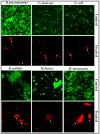Functional Attributes of Myco-Synthesized Silver Nanoparticles from Endophytic Fungi: A New Implication in Biomedical Applications
- PMID: 34071886
- PMCID: PMC8228282
- DOI: 10.3390/biology10060473
Functional Attributes of Myco-Synthesized Silver Nanoparticles from Endophytic Fungi: A New Implication in Biomedical Applications
Abstract
To develop a benign nanomaterial from biogenic sources, we have attempted to formulate and fabricate silver nanoparticles synthesized from the culture filtrate of an endophytic fungus Penicillium oxalicum strain LA-1 (PoAgNPs). The synthesized PoAgNPs were exclusively characterized through UV-vis absorption spectroscopy, Fourier Transform Infra-Red spectroscopy (FT-IR), X-ray powder diffraction (XRD), and Transmission Electron Microscopy (TEM) with energy dispersive X-ray spectroscopy (EDX). The synthesized nanoparticles showed strong absorbance around 430 nm with surface plasmon resonance (SPR) and exhibited a face-centered cubic crystalline nature in XRD analysis. Proteins presented in the culture filtrate acted as reducing, capping, and stabilization agents to form PoAgNPs. TEM analysis revealed the generation of polydispersed spherical PoAgNPs with an average size of 52.26 nm. The PoAgNPs showed excellent antibacterial activity against bacterial pathogens. The PoAgNPs induced a dose-dependent cytotoxic activity against human adenocarcinoma breast cancer cell lines (MDA-MB-231), and apoptotic morphological changes were observed by dual staining. Additionally, PoAgNPs demonstrated better larvicidal activity against the larvae of Culex quinquefasciatus. Moreover, the hemolytic test indicated that the as-synthesized PoAgNPs are a safe and biocompatible nanomaterial with versatile bio-applications.
Keywords: antibacterial activity; endophytic fungi; silver nanoparticles.
Conflict of interest statement
The authors declare no conflict of interest.
Figures













Similar articles
-
Green-Based Approach to Synthesize Silver Nanoparticles Using the Fungal Endophyte Penicillium oxalicum and Their Antimicrobial, Antioxidant, and In Vitro Anticancer Potential.ACS Omega. 2022 Dec 7;7(50):46653-46673. doi: 10.1021/acsomega.2c05605. eCollection 2022 Dec 20. ACS Omega. 2022. PMID: 36570288 Free PMC article.
-
Mycosynthesis of silver nanoparticles from endophytic Aspergillus flavipes AUMC 15772: ovat-statistical optimization, characterization and biological activities.Microb Cell Fact. 2023 Nov 6;22(1):228. doi: 10.1186/s12934-023-02238-4. Microb Cell Fact. 2023. PMID: 37932769 Free PMC article.
-
Endophytic actinomycetes Streptomyces spp mediated biosynthesis of copper oxide nanoparticles as a promising tool for biotechnological applications.J Biol Inorg Chem. 2019 May;24(3):377-393. doi: 10.1007/s00775-019-01654-5. Epub 2019 Mar 26. J Biol Inorg Chem. 2019. PMID: 30915551
-
Enhanced larvicidal, antibacterial, and photocatalytic efficacy of TiO2 nanohybrids green synthesized using the aqueous leaf extract of Parthenium hysterophorus.Environ Sci Pollut Res Int. 2018 Apr;25(11):10328-10339. doi: 10.1007/s11356-017-9177-0. Epub 2017 May 23. Environ Sci Pollut Res Int. 2018. PMID: 28537028
-
Characterization, Antibacterial and Antioxidant Properties of Silver Nanoparticles Synthesized from Aqueous Extracts of Allium sativum, Zingiber officinale, and Capsicum frutescens.Pharmacogn Mag. 2017 Jul;13(Suppl 2):S201-S208. doi: 10.4103/pm.pm_430_16. Epub 2017 Jul 11. Pharmacogn Mag. 2017. PMID: 28808381 Free PMC article.
Cited by
-
Diversity of Biogenic Nanoparticles Obtained by the Fungi-Mediated Synthesis: A Review.Biomimetics (Basel). 2022 Dec 20;8(1):1. doi: 10.3390/biomimetics8010001. Biomimetics (Basel). 2022. PMID: 36648787 Free PMC article. Review.
-
Recent Advances in Green Synthesis of Ag NPs for Extenuating Antimicrobial Resistance.Nanomaterials (Basel). 2022 Mar 28;12(7):1115. doi: 10.3390/nano12071115. Nanomaterials (Basel). 2022. PMID: 35407234 Free PMC article. Review.
-
Synthesis, Characterization and Biomedical Application of Silver Nanoparticles.Materials (Basel). 2022 Jan 6;15(2):427. doi: 10.3390/ma15020427. Materials (Basel). 2022. PMID: 35057145 Free PMC article. Review.
-
Visualization of the relationship between fungi and cancer from the perspective of bibliometric analysis.Heliyon. 2023 Jul 21;9(8):e18592. doi: 10.1016/j.heliyon.2023.e18592. eCollection 2023 Aug. Heliyon. 2023. PMID: 37529342 Free PMC article.
-
Biosynthesis of nanoparticles using microorganisms: A focus on endophytic fungi.Heliyon. 2024 Oct 19;10(21):e39636. doi: 10.1016/j.heliyon.2024.e39636. eCollection 2024 Nov 15. Heliyon. 2024. PMID: 39553612 Free PMC article. Review.
References
-
- Meera R. Nanostructures and their applications. Recent Res. Sci. Technol. 2012;4:14–19.
-
- Ejad R.M., Karimi S., Iravani S., Varma R.S. Plant-derived nanostructures: Types and applications. Green Chem. 2016;18:20–52.
-
- Marassi V., Di Cristo L., Smith S., Ortelli S., Blosi M., Costa A.L., Reschiglian P., Volkov Y., Prina-Mello A. Silver nanoparticles as a medical device in healthcare settings: A five-step approach for candidate screening of coating agents. R. Soc. Open Sci. 2018;5:171113. doi: 10.1098/rsos.171113. - DOI - PMC - PubMed
Grants and funding
LinkOut - more resources
Full Text Sources
Miscellaneous

